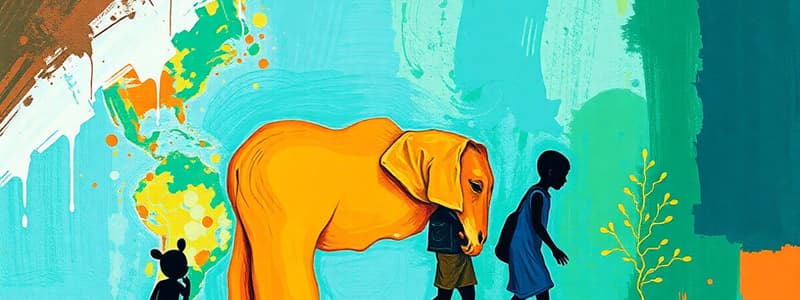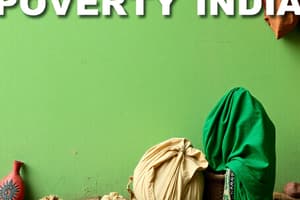Podcast
Questions and Answers
What is considered as the primary indicator of poverty in India?
What is considered as the primary indicator of poverty in India?
- Owning a car
- Employment status
- Fulfillment of basic needs (correct)
- Access to education
What was the poverty line in rural India in 2011?
What was the poverty line in rural India in 2011?
- 700 rupees
- 816 rupees (correct)
- 1000 rupees
- 1200 rupees
Which group is most likely to be categorized as vulnerable to poverty?
Which group is most likely to be categorized as vulnerable to poverty?
- Government employees
- Wealthy families
- Marginalized communities (correct)
- Urban professionals
How has poverty changed in India from 1993-94 to 2011?
How has poverty changed in India from 1993-94 to 2011?
What is the minimum calorie requirement for rural areas in India?
What is the minimum calorie requirement for rural areas in India?
Which state is noted for its investment in human development and women's empowerment leading to poverty reduction?
Which state is noted for its investment in human development and women's empowerment leading to poverty reduction?
What impact did the Green Revolution have on poverty reduction specifically in Punjab and Haryana?
What impact did the Green Revolution have on poverty reduction specifically in Punjab and Haryana?
Which of the following factors is NOT a contributing factor to poverty in India?
Which of the following factors is NOT a contributing factor to poverty in India?
What key measure does the Mahatma Gandhi National Rural Employment Guarantee Act (MGNREGA) focus on?
What key measure does the Mahatma Gandhi National Rural Employment Guarantee Act (MGNREGA) focus on?
Which state is associated with improved land reform contributing to poverty reduction?
Which state is associated with improved land reform contributing to poverty reduction?
How did China's poverty rate change from 1971 to 2015?
How did China's poverty rate change from 1971 to 2015?
What is one of the main strategies of the Indian government to combat poverty?
What is one of the main strategies of the Indian government to combat poverty?
Which of the following states is NOT listed as having a significant reduction in poverty?
Which of the following states is NOT listed as having a significant reduction in poverty?
Flashcards
Poverty Line in India
Poverty Line in India
The minimum amount of money a person needs to meet their basic needs like food, shelter, clothing, and clean water.
Vulnerable Groups in India
Vulnerable Groups in India
A group of people more likely to become poor, often due to lack of opportunities or marginalization.
Poverty Reduction in India
Poverty Reduction in India
The process of reducing the number of people living in poverty.
Minimum Food Requirement in India
Minimum Food Requirement in India
Signup and view all the flashcards
What is Poverty?
What is Poverty?
Signup and view all the flashcards
How did Punjab and Haryana reduce poverty?
How did Punjab and Haryana reduce poverty?
Signup and view all the flashcards
How did Kerala reduce poverty?
How did Kerala reduce poverty?
Signup and view all the flashcards
How did West Bengal reduce poverty?
How did West Bengal reduce poverty?
Signup and view all the flashcards
How did Andhra Pradesh and Tamil Nadu reduce poverty?
How did Andhra Pradesh and Tamil Nadu reduce poverty?
Signup and view all the flashcards
How did Gujarat and Maharashtra reduce poverty?
How did Gujarat and Maharashtra reduce poverty?
Signup and view all the flashcards
What is the impact of Colonialism on poverty in India?
What is the impact of Colonialism on poverty in India?
Signup and view all the flashcards
How does unequal resource distribution contribute to poverty?
How does unequal resource distribution contribute to poverty?
Signup and view all the flashcards
What is the impact of ineffective government policies on poverty in India?
What is the impact of ineffective government policies on poverty in India?
Signup and view all the flashcards
Study Notes
Poverty in India
- Poverty is a significant challenge in India since independence in 1947.
- One in four people in India lives in poverty.
- 270 million people lived in poverty in 2011.
- India has the highest number of poor people globally.
- Poverty is defined as a situation where basic needs like food, shelter, clothing, and clean water are unmet.
- The government uses a poverty line, calculated by income and consumption levels, to identify poverty.
- Rural poverty lines are lower than urban poverty lines.
- The rural poverty line in 2011 was 816 rupees, and the urban poverty line was 1000 rupees.
- The National Sample Survey Organization conducts a poverty survey every five years.
- In the U.S., poverty is sometimes measured based on car ownership, which is a luxury in India.
Minimum Food Requirement
- Minimum food requirements are measured in calories.
- Rural areas require 2400 calories daily, and urban areas require 2100 calories daily.
- Rural populations need more calories due to the physical demands of their work.
Poverty Reduction in Recent Years
- Poverty in India is decreasing, but significant poverty persists.
- 45% of India was poor in 1993-94.
- 37.2% of India was poor in 2004-05.
- 22% of India was poor in 2011.
- Poverty reduction is a positive trend, but ongoing efforts are needed.
Vulnerable Groups
- Vulnerable groups face a higher risk of poverty.
- They may lack access to opportunities or be marginalized.
State-Level Poverty Comparisons
- Poverty rates vary among Indian states.
- Bihar and Odisha have high poverty rates.
- Kerala, Andhra Pradesh, Tamil Nadu, Gujarat, West Bengal, Maharashtra, Punjab, and Haryana have seen significant poverty reductions.
Reasons for State-Level Poverty Reductions
- State-level poverty reductions stem from various factors:
- Punjab and Haryana: Increased agricultural production from the Green Revolution.
- Kerala: Investments in human development and women's empowerment.
- West Bengal: Improved land reforms and agricultural improvements.
- Andhra Pradesh and Tamil Nadu: Effective food grain distribution programs.
- Gujarat and Maharashtra: Increased economic activity in manufacturing and services sectors.
Global Poverty
- In 2017, the World Bank estimated that 9.9% of the global population was poor.
- Global poverty fell below 10% in 2010.
- Sub-Saharan Africa had a 41% poverty rate in 2005 and 2015.
- Latin America’s poverty dropped from 10% in 2005 to 4% in 2015.
- China's poverty rate decreased from 83% in 1971 to 0.7% in 2015.
Causes of Poverty in India
- Poverty in India results from a complex of factors:
- Legacy of Colonialism: British colonial policies hindered India's economic development.
- Unequal Resource Distribution: Wealth is concentrated among a few due to uneven land ownership.
- Lack of Effective Policies: Government policies were not consistently implemented.
- High Population Growth: Limited opportunities struggle to accommodate the growing population, resulting in unemployment.
- Indebtedness of Small Farmers: Loans and high-interest rates traps small farmers disproportionately.
Anti-Poverty Measures
- The Indian government implements programs to combat poverty:
- Promoting Economic Growth: Stimulating economic growth creates jobs and increases incomes.
- Anti-Poverty Programs:
- Mahatma Gandhi National Rural Employment Guarantee Act (MGNREGA): Launched in 2005, it provides job guarantees for rural populations.
- Prime Minister Rojgar Yojana (PMRY): Initiated in 1993, it assists educated individuals to establish businesses.
- Swarna Jayanti Gram Swarojgar Yojana (SGSY): Established in 1999, it focuses on improving the living standards of those below the poverty line through subsidies and loans.
Conclusion
- Poverty reduction in India is a significant challenge requiring continuous efforts.
- Poverty reduction is a long-term process demanding concerted efforts from the government, individuals, and society.
Studying That Suits You
Use AI to generate personalized quizzes and flashcards to suit your learning preferences.




